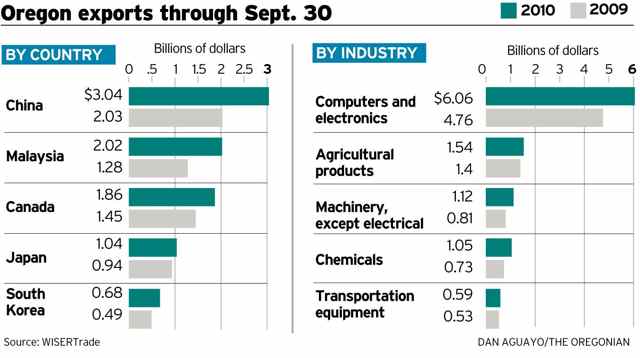forum
library
tutorial
contact

Oregon Exports Rebound, Boosting State Economy
by Richard ReadThe Oregonian, November 11, 2010
|
the film forum library tutorial contact |

|
Oregon Exports Rebound, Boosting State Economy
by Richard ReadThe Oregonian, November 11, 2010 |
 Northwest farms and factories are shipping more wheat, food products and electronic goods abroad these days, helping the region climb back from the recession.
Northwest farms and factories are shipping more wheat, food products and electronic goods abroad these days, helping the region climb back from the recession.
Oregon's exports jumped 25 percent during the first nine months of 2010, compared with the same period last year. The state's foreign sales surpassed $13 billion in the period ending Sept. 30 as Malaysia displaced Canada to become Oregon's second-biggest customer.
Exports to China, Oregon's largest customer by far, shot up 50 percent compared with the first nine months of last year, exceeding $3 billion. High-tech goods led the export surge.
The big increases would be more impressive if they weren't coming off a low base, what with depressed exports last year due to the global recession. But economists and trade experts say strong export growth is especially encouraging for Oregon, where other key sectors languish amid 10.6 percent unemployment.
"From a Northwest perspective, this is good stuff, this is one of our strengths," said Portland economist John Mitchell. "The recovery's a year and a quarter old. We're not moving towards it, we're in it. It's just frustratingly slow."
Oregon's exports are rebounding slightly faster than those of the nation overall, and growth of its sales to China are significantly outpacing the national increase. Chinese buyers loom much larger for Oregon than for the nation, which counts China a distant third customer behind Canada and Mexico.
In the Northwest, business and political leaders seem less likely to criticize China for predatory trade and currency manipulation, charges heard more frequently in other parts of the United States.
This week in Washington, D.C., Alan Tonelson of the U.S. Business and Industry Council said the odds of a U.S. and global relapse would remain high without "strong unilateral U.S. actions starting with higher tariffs on China and other currency manipulators."
The head of the Alliance for American Manufacturing called on participants in the Group of 20 summit in Seoul, South Korea, to get tough with China. "Massive monthly trade deficits with China are extremely disturbing at a time of recession and high unemployment in the U.S.," said Scott Paul, alliance executive director.
The United States' merchandise trade deficit with China edged down by 0.75 percent in September, from $28.04 billion to $27.83 billion.
As Gov.-elect John Kitzhaber prepares to lobby for Oregon in the Capitol, Walt Evans, a Schwabe Williamson & Wyatt lawyer in Portland who is active on trade issues, says Oregon traders would benefit from federal support for small-business exports, the Columbia Crossing bridge, and rail and highway improvements near the Port of Portland.
State export data released this week by WISERTrade, a Massachusetts-based number-crunching service, showed Oregon exports reaching almost $13.2 billion this year for the period ending Sept. 30, compared with $10.5 billion for the same period last year.
For all of 2009, Oregon exports reached $14.9 billion. That was down sharply from a 2008 peak of $19.4 billion.
The state's high-tech exports are leading 2010's charge, exceeding $6 billion through Sept. 30. Agricultural products, machinery and chemicals are also up.
The Port of Portland and other ports are seeing big increases in wheat exports during a rare period when both demand and prices are up. Wildfires and drought in Russia have led to a wheat-export ban there, and decreased crop production in Australia also has helped drive up prices.
Exports of Canadian potash, a fertilizer ingredient, are surging from Portland, said Josh Thomas, a Port of Portland spokesman. But Portland's exports of products packed in shipping containers have increased only slightly, he said.
Only three international container shipping services call on Portland these days, limiting options for exporters. As a result, "There's still some leakage" of cargo, Thomas said, "particularly to the Puget Sound ports, simply because they have service offerings that we don't."
One factor helping exports, Thomas said, is the 3 feet of draft recently added to the 40-foot Columbia River shipping channel.
The extra depth allows longshoremen to load as many as 500 more 40-foot containers on a ship. Likewise, Thomas said, a bulk vessel can carry on average as many as 10,000 more tons.
learn more on topics covered in the film
see the video
read the script
learn the songs
discussion forum
